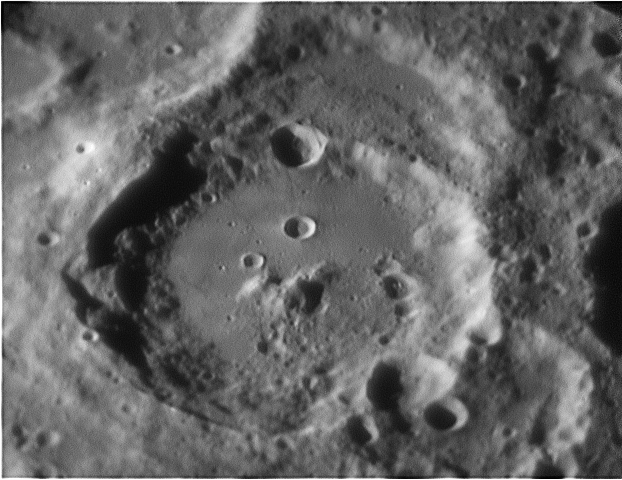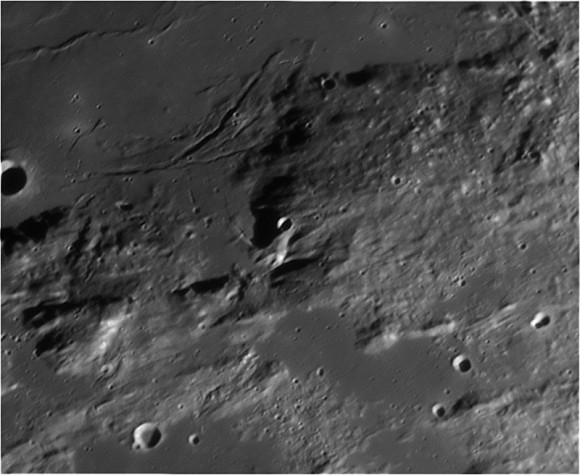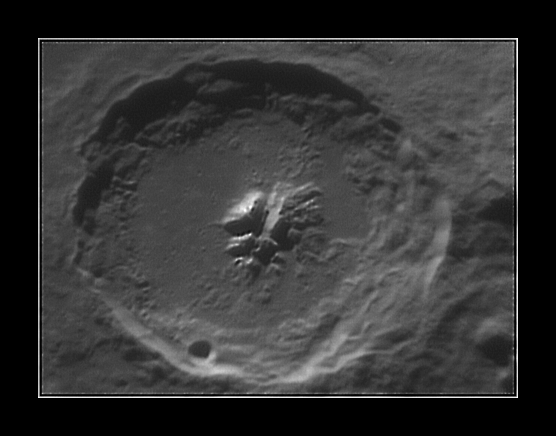Greetings, fellow SkyWatchers! If we’ve explored the Moon in “Astronomy For Kids”, then by all means let’s explore the Moon in Astronomy for BIG kids! This weekend would be an great opportunity to dust off your telescopes or binoculars and do a little moongazing, because… Here’s what’s up!
Friday, April 11 – Tonight we’ll begin our SkyWatcher’s Weekend by heading toward the lunar surface to view a very fine old crater on the northwest shore of Mare Nectaris – Theophilus. Slightly south of midpoint on the terminator, this crater contains an unusually large multiple-peaked central mountain which can be spotted in binoculars. Theophilus is an odd crater: it’s shaped like a parabola – with no area on the floor being flat. It stretches across a distance of 100 kilometers and dives down 440 meters below the surface. Viewable in binoculars, Theophilus tonight it will appear dark, shadowed by its massive west wall, but if you’re using a telescope, look for sunrise on its 1400 meter summit!
 Saturday, April 12 – Today marks the 1851 birth of Edward Maunder – a bank teller turned assistant Royal Astronomer. Assigned to photographing and cataloging sunspots, Maunder was the first to discover solar minimum times and equate these with climate change. Maunder was also the first to suggest that Mars had no “canals,” only delicate changes in surface features. Smart man!
Saturday, April 12 – Today marks the 1851 birth of Edward Maunder – a bank teller turned assistant Royal Astronomer. Assigned to photographing and cataloging sunspots, Maunder was the first to discover solar minimum times and equate these with climate change. Maunder was also the first to suggest that Mars had no “canals,” only delicate changes in surface features. Smart man!
On Saturday night, Mars will play a very important role in observing as it will be slightly more than a degree away from the Moon’s limb for many observers. As grand as observing can be when the planet is near, it doesn’t even come close to the details that can be seen on the Moon. An outstanding feature visible tonight will be crater Maurolycus just southwest of the three rings of Theophilus, Cyrillus and Catharina. This Lunar Club challenge spans 114 kilometers and goes below the lunar surface by 4730 meters. Be sure to look for Gemma Frisius just to its north.
 Sunday, April 13 – Tonight, let’s have a look at the Moon as challenge craters Cassini and Cassini A have now come into view just south of the black slash of the Alpine Valley. For more advanced lunar observers, head a bit further south to the Haemus Mountains to look for the bright punctuation of a small crater. You’ll find it right on the southwest shore of Mare Serenitatis! Now power up and look for a curious feature with an even more curious name…Rima Sulpicius Gallus. It is nothing more than a lunar wrinkle which accompanies the crater of the same name – a long-gone Roman counselor. Can you trace its 90 kilometer length?
Sunday, April 13 – Tonight, let’s have a look at the Moon as challenge craters Cassini and Cassini A have now come into view just south of the black slash of the Alpine Valley. For more advanced lunar observers, head a bit further south to the Haemus Mountains to look for the bright punctuation of a small crater. You’ll find it right on the southwest shore of Mare Serenitatis! Now power up and look for a curious feature with an even more curious name…Rima Sulpicius Gallus. It is nothing more than a lunar wrinkle which accompanies the crater of the same name – a long-gone Roman counselor. Can you trace its 90 kilometer length?
Wishing you clear skies!
This week’s awesome lunar images belong to noneother than Wes Higgins. Many thanks!


We won’t get rid of the clouds and snow until late Saturday, but Sunday night, I’ll be there!
Another great feature. Hope to be out with the scopes this weekend as Saturday night is claimed to be clear.
Look out Moon here I come.
Brian.
Last night April 10 2008 on my way to work I saw what looked like to me a falling star in the eastern sky at 10:40 p.m. After watching it fall it turned out to burn brighter and get larger with an orange glow and then turn to its last color of blue before it was done its decent. How do I find out what it was and where it was. My location at the time was was interstate 78 in Brighton Iowa heading East. Thank you for any information that you can provide for me.
Hi, Carrie!
From your description, I would say you spotted a piece of “space junk” burning up in our atmosphere.
Pretty impressive, aren’t they?
Yeah I would have to say it was. At first is was just the coolest thing in the world and then reality hits when its still a ball burning up and its not stoping while its dropping. I was hoping that I would open up the news paper today and read all about it. Very humbling to be reminded how very insignificant one is to this amazing world. Thank you for the reply
I’m in Illinois.
It’s 3am and I’m looking South.
It’s a VERY bright object.
Is it Saturn?
Thanks.